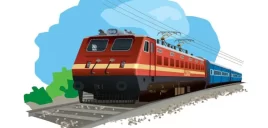The overall schedules and numbers of trains, as reflected in the published passenger timetables and working timetables, are decided in advance based on consideration of the operational aspects such as loco availability, loco changeovers, crew changes, section capacity, etc.
In implementing these schedules, Deputy Chief Controllers or Dispatchers set the day-to-day policies and finalize plans for the schedules and precedence of various passenger and freight trains in the sections that they are in charge of. Each section or portion of the routes under the dispatcher has Section Controllers who are responsible for implementing the plans drawn up by the dispatchers.
Section controllers regulate traffic in their sections based on track capacity, availability of locos and readiness of trains, etc. Section controllers also control the movement of rakes and locos to and from sheds and yards. Goods trains are almost exclusively under the control of section controllers (unlike passenger trains where the station staff starting with the station masters at each station are also involved). In suburban sections, a separate group of section controllers may control the movement of EMUs, ensuring that specific units run on specific routes, that particular EMU units return to their car sheds at the end of the day, etc. Section controllers are also responsible for tracking yard balances of wagons and coaches, tracking reports of trains and engine movements. They also serve as the primary link between the control office and the larger IR apparatus and the line staff (cabin crew, loco crew, etc.).
A control chart is drawn up by the section controller or his staff for each day. The chart plots distance along one axis (subdivided by block sections, and showing stations, level crossings, etc., and time along the other. The trains’ paths are plotted on the chart to show the progress they are making; the slopes of the paths indicate the speeds. Colours are used to mark out different categories of trains; e.g., red for mail and express trains, blue for ordinary passenger trains, and black for goods trains. Crack or link goods trains are indicated by special colours. If a train is stabled at a station, a horizontal red line is used to denote that. If a train is taking longer than usual to clear a section, it’s actual path is shown by a solid line, while the scheduled path is shown by a dotted line. Annotations are made for any unusual occurrences, e.g., late starts, speed restrictions, etc. For work trains, the detention at stations is indicated in terms of shunting, crossing, line clear, and any extra time taken by the driver to start is indicated. Normally, at the end of a run on a section, the guard for a passenger train hands in his report of timings and reasons for detentions along the way, so that they can be reconciled with the control chart.
The cabin control crew are in charge of implementing the directives of the section controllers by operating the points, signals, and interlockings, and are generally concerned with the safe operation and movement of trains in and out of the particular sections they are in charge of. They technically operate under the authority of the station master of the station, who has ultimate authority on which trains enter, pass through, and depart his station.
In large stations, though, the station master’s office does not concern itself with the details of the traffic through the station, leaving that entirely to the section controllers and the cabin control crew who work in coordination with them. (The arrangement where the Station Master or his staff exclusively determine which platforms trains arrive at and leave from is known as Master’s Acceptance.) At smaller stations, however, the station master and his staff have a more direct hand in the details of the traffic through the station and how it is scheduled.
Certain trains may have high operational priority or precedence seemingly out of proportion to their schedule constraints or other considerations, because they are especially monitored by the Railway Board or the Ministry of Railways (“Minister’s list” and “board-monitored” trains). The choice of these trains is usually a political one; often these are the ‘prestigious’ trains of various zones, the Rajdhanis, and the Shatabdis.
Local passenger trains and EMU / MEMU trains that serve a large number of halts are often given a higher precedence than long-distance mail/express and superfast trains (generally excepting the Rajdhanis / Shatabdis and other special trains as mentioned above). One reason for this is that the stopping trains usually serve large numbers of local commuters and are thus important for the local population. Another reason is that they are directly under the division or zone concerned unlike the long-distance trains where the responsibility for punctuality can often be placed on the preceding or following division or zone. E.g., [12/04] the 709 Surat-Vadodara MEMU precedes the Ahmedabad-bound Karnavati Exp. till Vadodara. Sometimes even prestigious trains may be held up in this way. E.g., [12/04] the 2951 Mumbai Rajdhani trails the Sayajinagari Exp. till Vadodara. It used to overtake the Sayajinagari Exp. at Bharuch, but this caused a lot of delays for commuters on the MEMU and the overtake was eliminated.
To improve track utilization, goods trains, which do not ordinarily stop at any of the passenger halts, can be iven precedence over passenger trains so that they have a clear run. E.g., [12/04] a goods train is seen to depart Ahmedabad at 2155, just five minutes before the Mumbai-bound Gujarat Mail; this makes sense because the goods can run clear through to Vadodara whereas the Mail has to make at least half a dozen halts and takes over 2 hours for the 100km distance. ‘Important’ goods trains such as the ‘Con-Raj’ container rakes, the dedicated parcel services, etc., are generally the best candidates for such instances of being given precedence over passenger trains.
There may be additional Deputy Controllers who have specific control over the running of freight trains, including their scheduling, loading/unloading, and are responsible for monitoring their progress.
Locomotive Controller
The locomotive controller or other official of the loco shed determines which locomotives are available for service and when. For electric locos, the official handling this is designated the Traction Loco Controller. The engine link or locomotive link published by the zonal railway from time to time details the high-level allotments of locomotives for train runs within the zone.
Rake Links
The overall high-level plan for rake movements is described in a rake link issued by a zonal railway, which has details of the planned rake compositions and rake movements for all trains handled by the zone.
This has the details of which trains share rakes with which other trains, how and when rakes need to be formed or split up, and many other details: composition, marshalling order, vacuum or air braked, permissible loads, train watering, postal accommodation, sanctioned runs, locomotive allotment, maintenance stations, lie-over periods, distance (km) earned by a rake in a round trip, instructions for sending sick/defective coaches or coaches due for POH to shops.
This is drawn up keeping in mind asset utilization and maintenance schedules for the stock. The day-to-day operational schedules are then drawn up with this as the basis and used by the operational staff / marshalling yard staff. The rake link is also used by the reservation staff to determine the sizes and distribution of reserved accommodation quotas.
Here is a sample rake link (MS Word document).
Station scheduling
At each station, based on the train schedules, a platform and siding occupancy chart is drawn up. This provides, for each day of the week, an indication of which platforms and sidings are occupied by which trains at what times. Introducing a new train at a station (originating, or passing through) involves finding an appropriate slot in this chart.
The overall scheduling, traffic planning, and operational aspects of a division are under the control of the Chief Operations Manager of a division who is ultimately responsible for the performance of the division in terms of punctuality, efficiency, etc.
In recent years IR has increased its use of computerized management systems to keep track of rolling stock and utilize it efficiently. The FOIS (Freight Operations Information System) and the COIS (Coaching Operations Information System – introduced 2003) help manage the movements, schedules, and punctuality of freight and coaching stock, respectively, much better. FOIS is a two-tier system to keep track of freight operations. The central reporting and decision support system that keeps track of all moving freight assets is located at New Delhi. Five zonal systems (at New Delhi, Mumbai, Kolkata, Chennai, and Secunderabad) process local reporting and administration tasks associated with regional freight operations. The FOIS and COIS networks include many ‘Activity Reporting Centres’, including goods sheds and sidings, transshipment points, interchanges, wagon repair workshops, carriage and wagon locomotive sheds, fuel stations, crew change locations, stations, and locomotive workshops. Data from all of these is incorporated into the system.
Source – IFRCA.org
Disclaimer: The Information /News /Video provided in this Platform has been collected from different sources. We Believe that “Knowledge Is Power” and our aim is to create general awareness among people and make them powerful through easily accessible Information. NOTE: We do not take any responsibility of authenticity of Information/News/Videos.
This entry was posted in 2 Railway Employee, STUDY NEW, Railway Employee











